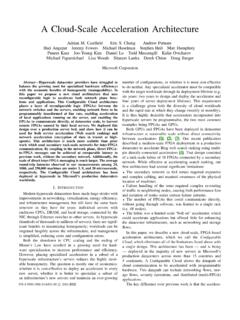Transcription of The Physics of Siege Weapons STEM Club Resource Pack
1 With support from Oxfordshire County Council, Science Oxford is pleased to present;. catapult Engineering The Physics of Siege Weapons stem club Resource pack Introduction: catapult engineering involves using stored energy to hurl a projectile without using any explosives. The stored energy comes from building mechanisms that use tension, torque and gravity. The main types of catapult are the trebuchet and the Mangonel. In this project you will be building and test different Siege Weapons , discovering the mechanisms that make them work and how to improve them, before building your own, ultimate Siege weapon.
2 A Trebuchet* A Mangonel*. *"Trebuchet". Licensed under Creative Commons Attribution-Share Alike via Wikimedia Commons - #mediaviewer/ *"Replica catapult ". Licensed under Creative Commons Attribution-Share Alike via Wikimedia Commons - #mediaviewer/ The Mangonel: The Mangonel is probably the most familiar looking type of catapult . It involves stretching or winding up a long piece of rope attached directly (or indirectly) to a throwing arm, therefore putting it under tension. When released, the rope will want to return to its relaxed length and will therefore create a pulling force in the opposite direction, pulling on whatever object it is attached to.
3 Tension is effectively the opposite of compression. The angle at which the throwing arm is pulled back to will affect both the distance the projectile will travel and also the height that it reaches when in the air. Throwing arm Rope Frame Restraining Rope The restraining rope is released and the previously strained and taught rope pulls back to its original position The Trebuchet: The Trebuchet was one of the more accurate and efficient types of catapult used in ancient times. It worked by using the energy of a falling counterweight to rotate a beam around a pivot resulting in the release of whatever projectile was loaded into the sling at the other end of the beam.
4 Pivot point Counter weight Beam Sling As the counterweight drops downwards the beam swings round and launches the attached sling into the air Suggested Timetable: Stage 1: Introduction to catapult Engineering Introduction to Siege Weapons and the engineering behind them Stage 2: Initial Investigations ( Resource sheets). Investigate the components that make the best catapult Stage 3: Planning and Design ( Resource sheets). Start to plan and design your own Weapon Stage 4: Construction Start Building! Stage 5: Testing Test your design to see what works Stage 6: Modification Make changes to your design to make it even better!
5 Stage 7: Demonstration and Competition Show off your catapult and put it to the test! Stage 2: Initial Investigations Investigating Launch Angles In this investigation you will be exploring the effect the launch angle has on the distance a projectile (ball) travels. To do this you will be using the Xpult' catapult shown below. The Xpult' catapult operates similarly to a modern day mangonel; a rubber band stores elastic potential energy as it is stretched, which is released as kinetic energy when it is released. Equipment needed: Xpult' catapult Tape measure Pen Target (optional).
6 Paper What to do: Xpult' catapult kit: catapult itself including a locking pin Three rubber bands A table tennis ball and a small white plastic perforated ball. A clamp for attaching the catapult to the table Set up the catapult as show below: Unfold the catapult by removing the locking pin and swinging the aluminium launch lever all the way round to the other side of the black plastic base. Clamp the black base to the edge of a table. Thread a rubber band through the large hole in the aluminium disc, and hook it onto the designated hooks each side of the aluminium lever.
7 Re-insert the pin into one of the holes, for now anywhere between 30-60 . Set up a tape measure from the base of your catapult all the way across the room, covering at least 3 metres. If your tables don't stretch 3 metres, you can always place the tape measure on the floor Rubber band Locking pin Clamp Pull-back angle read here Launch angle read here Allocate roles within your group (although you can swap around so that everybody gets a turn and everything): A spotter- this person is in charge of determining the exact landing location of the ball A shooter- this person operates the catapult An Analyst- this person is in charge of entering the data into the table correctly Initial tests- to understand the relationship between the launch angle and the pull- back angle Set the launch angle to 45 (note that you read the launch angle at the bottom edge of the black plastic base).
8 You can experiment with different launch angles later, but for now start with 45 . Start with a pull-back angle of 20 , the white perforated ball and just one rubber band. Launch the ball three times, and record each distance. Calculate the median of the distances, this is just the middle distance (not the smallest or the largest, the one in between). Calculate the range of the distances- this is the difference between the furthest shot and the nearest shot (biggest number-smallest number). Now move the pull-back angle by 10 , so you go to 30 and repeat the experiment three times.
9 Continue to increase the pull-back angle in increments of 10 until you have reached a pull-back angle of 90 or higher. The ball has a tendency to fall out of the cup if you pull the catapult arm too far back. Continue to calculate the median and range for each different pull-back angle and fill in the table below. Experiment 1 Launch angle = 45 Number of rubber bands = 1. Pull-back angle Shot 1 (cm) Shot 2 (cm) Shot 3 (cm) Median Range (cm). ( ) (cm). Example 28 25 32 28 32-25=7. 10. 20. 30. 40. 50. 60. 70. 80. 90. 100. 110. 120. Analysing your data One of the quickest ways to analyse data is to draw a graph.
10 Put the pull-back angle on the y-axis (vertical column) and the distance of the median shot (grey column) on the x-axis (horizontal axis). Create your own or fill in the one below. Experiment 1 Launch angle = 45 Number of rubber bands = 1. 12. 0. 11. 0. 10. 0. 90. 80. Pull-back angle ( ). 70. 60. 50. 40. 30. 20. 10. 0 20 40 60 80 100 12 14 16 180 20 22 24 26 28 30 32 34. 0 0 0 0 0 0 0 0 0 0 0. Median distance ball travelled (cm). Another way to analyse your data is to look at the range column of your table. The smaller your range, the more consistent your catapult was for that pull back angle.






